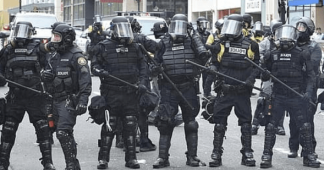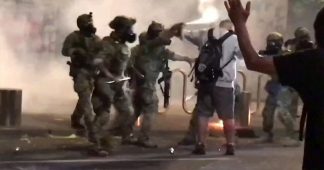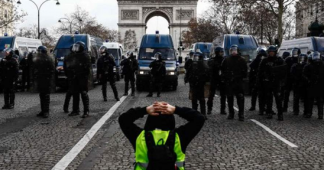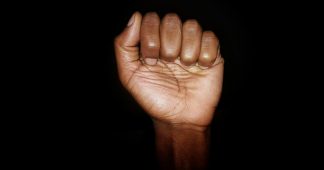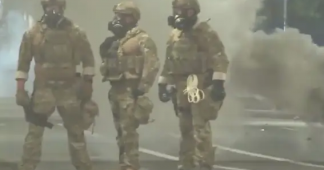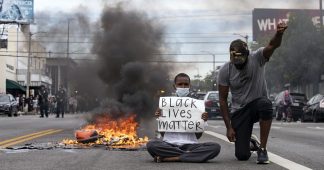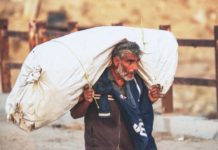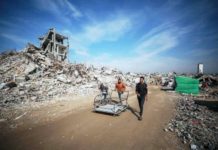Now more than ever, we need to debunk the myth that human rights are an issue in other countries, but not here in the U.S.
A re-surged movement against police brutality, white supremacy, and state violence — come to be known as the largest sustained mobilization in modern history in the United States — continues to reignite public discourse around issues of systemic racism and the need to organize collectively across race lines for transformative change.
It follows that this new wave of resistance has been met with violent and ruthless political repression: the militarization of police forces, a rise in mass arrests and indefinite detentions, hyper-criminalization of the right to protest, bolstered state surveillance of activist activities, and a spike in extrajudicial executions with the support of emboldened right-wing paramilitaries and reignited white supremacist terrorism.
In order to seek justice, we can’t hide from the truth. As human rights monitors and an organization that seeks to equip activists with the infrastructure they need to build a stronger and more unified grassroots movement, we’ve developed an informational report summarizing research findings and documenting human rights violations related to this most recent wave of political repression. Our most recent findings are summarized below.
 Militarized police forces continue mass arrests of protesters and Black people
Militarized police forces continue mass arrests of protesters and Black people
Since late May, there have been at least 55 federal and National Guard deployments across the country, working alongside mobilized forces affiliated with the Operations Legend — a sustained and systematic law enforcement initiative in which federal law enforcement agencies cooperate with local and state law enforcement officials, first launched in Kansas City on July 8.
It’s followed that protest sites such as New York, Los Angeles, Chicago, Las Vegas, Houston, Louisville, Santa Monica, Portland, Kenosha, and Minneapolis continue to see spikes in protest-related mass arrests and indefinite detentions. The last time there was a comparable spike in arrests and arbitrary detentions was during the Ferguson uprising that followed the police shooting of Michael Brown in 2014; however, those numbers still don’t measure up to today’s, which by now exceeds 10,000 protesters across the country.
While there is no comprehensive breakdown of arrest demographics nationwide, analyses of city and county arrest records and polls from think tanks such as the Pew Research Center further reinforce the racial bias evident in U.S. policing and mass incarceration. Even though 46% of protesters surveyed by Pew Research Center earlier this summer are white, there is a consistently high representation of Black people who have been arrested and indefinitely detained for protest-related activities in various cities.
Federal agents are still roaming our streets
Since early June, undercover police and federal agents lacking legible insignia to indicate who they are or whom they work for have been consistently identified at protests throughout the country. What began as the presence of anonymous police officers driving around in unmarked vehicles and forcefully detaining protesters without prior justification (sometimes releasing them with no record of arrest) was taken to another level in July.
Since the issuing of Executive Order 13933, the launching of Operations Legend and the unilateral deployment of federal troops in cities such as Portland, Seattle, and Kenosha that began in mid-July, the Trump Administration has given the Department of Homeland Security — most notably the Customs and Border Protection’s (CBP) branch’s elite force, the Border Patrol Tactical Unit (BORTAC), the green light to enter major cities to repress protests.
BORTAC agents have been spotted at protests across the country, most recently in Kenosha following the eruption of protests triggered by the police shooting of Jacob Blake. Videos have emerged showing police working alongside federal law enforcement agents to detain protesters and force them into unmarked vehicles on August 26, during a protest that followed the police shooting of Jacob Blake. According to activists, at least 12 protesters were arrested this way.
Endless police brutality and paramilitary violence against people of color and protesters
According to The Guardian, there has not been a single week without an incidence of police brutality against civilians or journalists during protests since late May. As mobilizations around racism and police brutality persist in the wake of widely documented police violence against people of color and protesters, so too has the mobilization of armed right-wing counter-protesters.
Five months into the social unrest that erupted in late May, research has revealed some important findings. There have been nearly 1,000 documented instances of police brutality against civilians and journalists during anti-racist protests, according to data collected by Bellingcat and Forensic Architecture, and analyzed by The Guardian in late October. Legal observers have consistently reported accounts of police attacking people with batons and bicycles, running protesters down with horses and police vehicles, and freely deploying tear gas, pepper spray, rubber and bean bag bullets, and flash-bang grenades. According to our research, there have been at least 22 extrajudicial executions of protesters and/or civilians of color killed during their interactions with on-duty law enforcement agents since late May.
All against the backdrop of a growing far-right nationalist movement, a rise in hate crimes, and the mobilization of neofascist paramilitary groups — “Back the Blue” rallies, counter-demonstrations and right-wing terrorist attacks have produced a number of protest-related extrajudicial killings carried out by non-state agents. According to our research, there have been at least 17 extrajudicial killings of protesters and/or people of color carried out by civilians and paramilitary forces.
To make matters worse, documented evidence shows a trend of tolerance for collaboration with the far-right from law enforcement agents. According to research from the Bellingcat Forensic Architecture analyzed by the Guardian in late October, there have been at least 19 incidents of police being permissive to far-right individuals and showing double-standards when confronted with white supremacists. This comes as no surprise, considering there has been a rise in self-proclaimed white supremacist group members infiltrating U.S. police forces throughout the country in recent years.
It’s become very clear that white supremacists are doing the work of the state. Just recently, following the right-wing terrorist attack resulting in the death of two protesters in Kenosha in August, Pres. Trump defended the perpetrator, Kenosha Guard Militia member Kyle Rittenhouse, claiming that protesters had been “violently attacking him.” When asked to disavow white supremacists during a presidential debate, Pres. Trump addressed one of his supporting neo-fascist organizations, the Proud Boys, with the words, “stand back, but stand by.”
Hyper-criminalization of protests has brought a new wave of political prisoners
Since the Ferguson uprising and the wave of protests against the Dakota Access Pipeline in 2016, the institutionalization of new legal restrictions on protests has enabled a new trend of criminalization of protest-related actions and even harsher persecution of protesters by the justice system. Now, arbitrary and often fabricated charges against protesters are being used to further enhance cases, lead to higher bail amounts and, ultimately, lead to longer potential prison sentences.
Over 300 people across 29 states have been charged with federal crimes related to protests, many of whom face long-term sentences ranging from six months to a lifetime in prison. The issuing of Executive Order 13933, which encourages prosecutions “to the fullest extent” against anyone who vandalizes public monuments, has further fueled the justice system’s vicious persecution of protesters. In multiple states, protesters involved in attempts to damage local or state property are facing “terrorism” charges.
Based on our own statistics derived from our Political Prisoners in the U.S.A. informational page, there has been at least a 12% increase (at least nine new individuals) in the number of political prisoners in the U.S. since the start of widespread demonstrations in late May. We document their names in the report.
The fight continues in the streets!
First and foremost, we demand jurisdictions to drop all charges against protesters and decriminalize the universal human right to assembly. We demand a repeal of Executive Order 13933 and the withdrawal of federal troops from our streets.
But it doesn’t end there. The historical violence people of color have faced and its extension to the movement against racism and state violence are symptoms of a broken system and won’t stop without a collective and sustained effort to defund police forces and prisons and reinvest capital in favor of safe and equitable alternatives. We need to focus on addressing the real dangers to society: widespread poverty and disenfranchisement, a complete lack of police accountability, and the traumatic impacts of the carceral system.
Election anxiety is high, and rightfully so. Regardless of the outcomes of Tuesday’s presidential election, the struggle continues in the streets. The future is ours, and the people are fighting back.
Published at https://afgj.org
